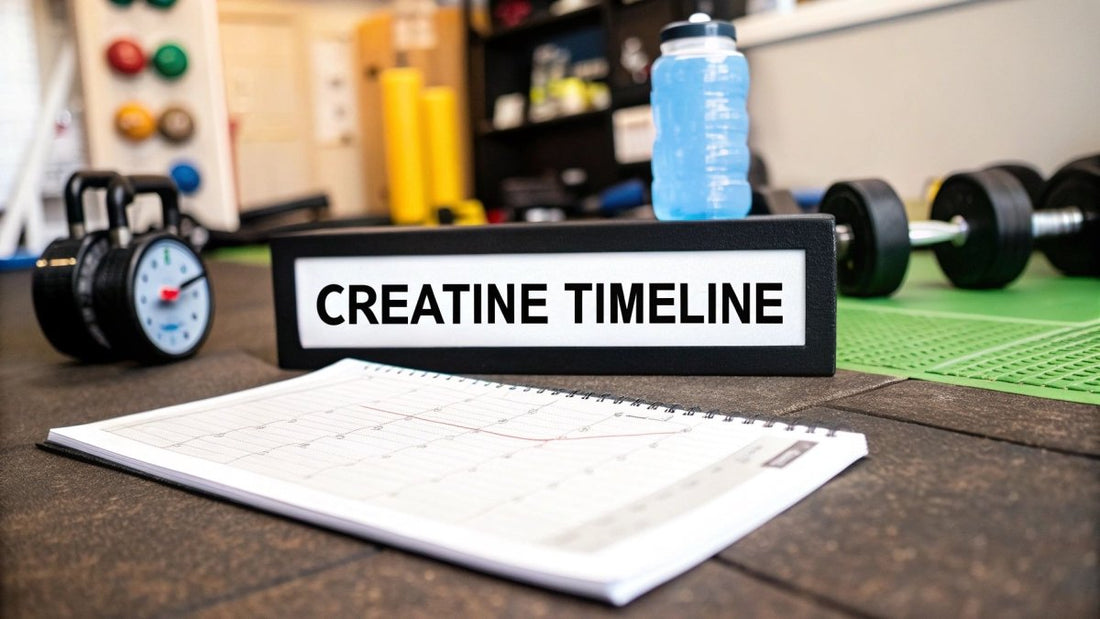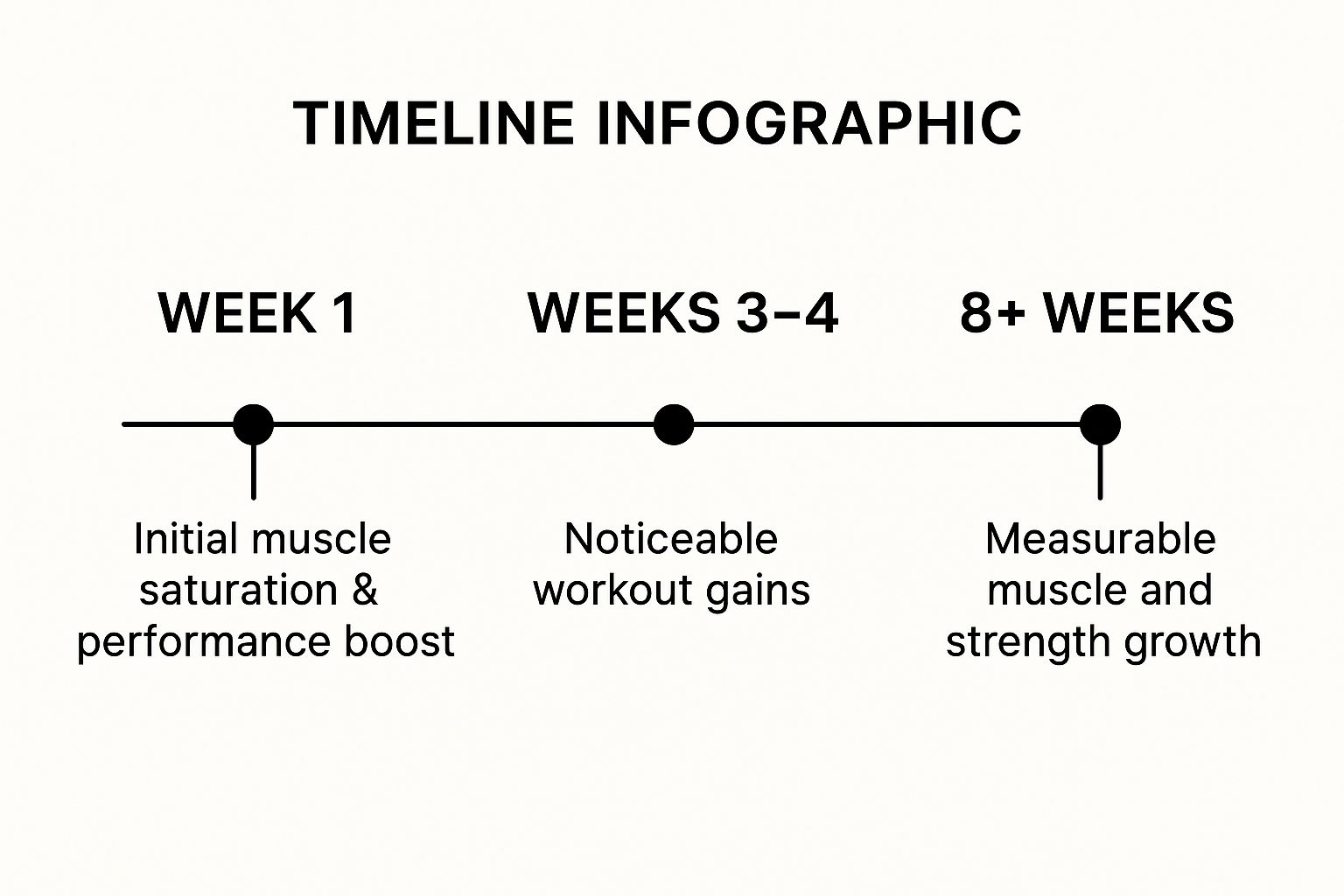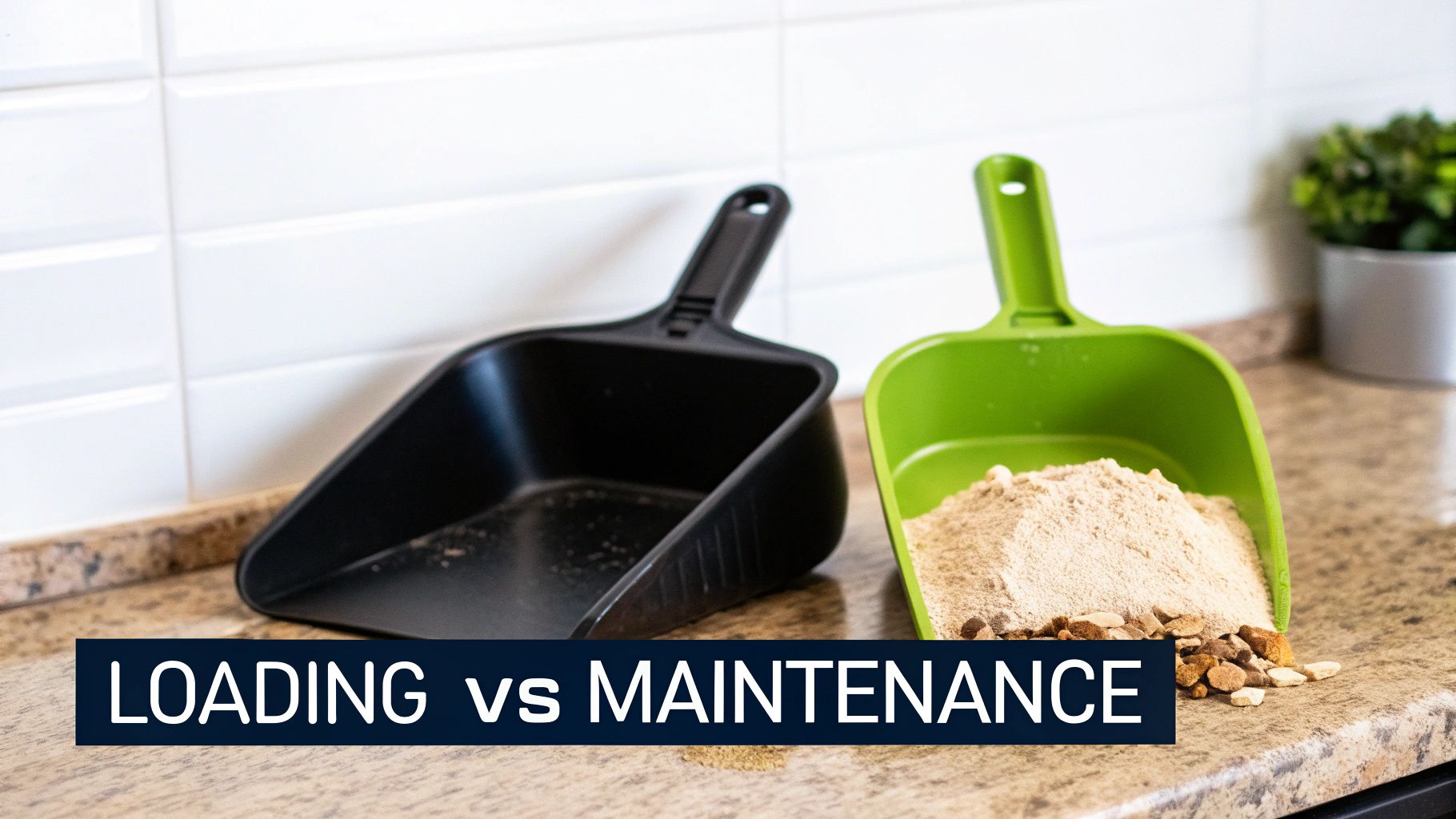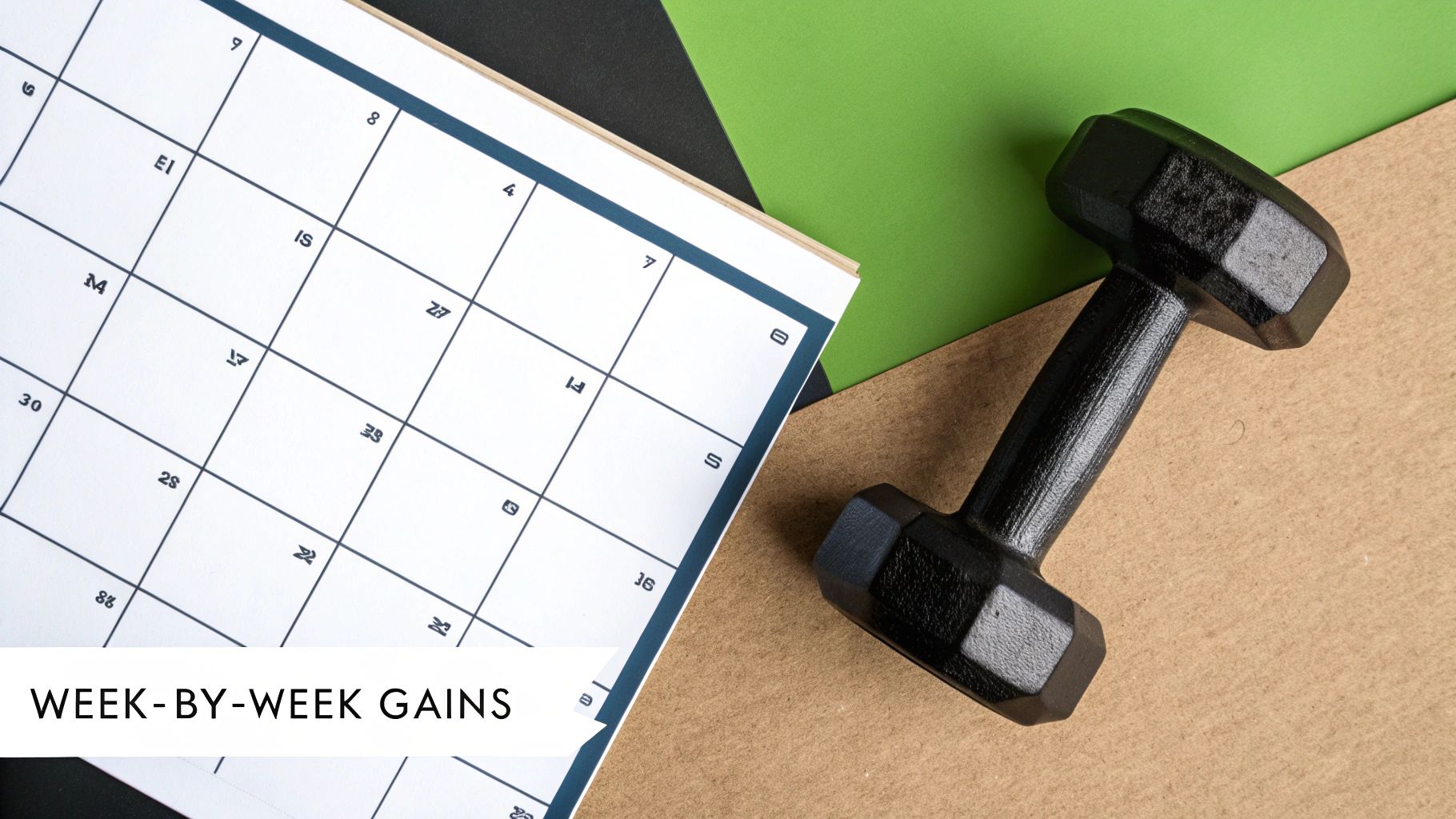
How Long Until Creatine Works? A Realistic Timeline
Share
So, you're ready to start creatine and want to know the big question: how long until it actually starts working? The short answer is, it depends on your approach. If you opt for a loading phase, you could start feeling the performance benefits in as little as one week. If you skip the loading and stick to a standard daily dose, you're looking at closer to three or four weeks to see the same results.
Your Guide to the Creatine Results Timeline
Setting the right expectations is key, and understanding the creatine timeline will help you do just that. The whole game is about saturating your muscles with phosphocreatine, which is the high-energy compound that fuels those explosive movements in the gym.
Think of your muscles like a gas tank. You can either hit the high-flow pump and fill it up fast—that's your loading phase. Or, you can top it off a little bit each day until it's full—that's the standard maintenance dose. Both methods get you to a full tank eventually; the only difference is the time it takes to get there.
You'll know it's working when you notice your muscles look a bit fuller and you see a slight bump on the scale. Don't panic! This is just water weight being pulled into your muscle cells, a great sign that creatine is being stored where it needs to be. From that point on, the real performance benefits start to build.
This infographic breaks down what you can expect and when.

As you can see, some of the initial effects happen pretty quickly. But the more significant gains in raw strength and muscle size come from sticking with it consistently over several weeks. When it comes to creatine, patience and consistency are your best friends.
Creatine Effectiveness Timeline At a Glance
To make it even clearer, let's compare the two common strategies side-by-side. This table breaks down what you can generally expect whether you choose to load or go with a steady maintenance dose from day one.
| Timeframe | Expected Outcome with Loading Phase (20g/day) | Expected Outcome with Maintenance Dose (3-5g/day) |
|---|---|---|
| Week 1 | Muscle saturation begins. You might notice fuller muscles and a 2-4 lb weight increase. Initial strength and power boosts in the gym. | Minimal noticeable effects as muscle stores slowly begin to build. |
| Weeks 2-4 | Full muscle saturation achieved. Noticeable improvements in reps, endurance, and workout capacity. | Muscle saturation is reached around week 3 or 4. You'll start to feel the same benefits as the loading phase, just on a delayed timeline. |
| 1 Month+ | Consistent performance gains. You're now in the maintenance phase (3-5g/day) and experiencing the full benefits of optimized creatine stores. | Full benefits are now active. Strength, power, and muscle growth are noticeably enhanced with consistent training. |
No matter which path you take, the end destination is the same: fully saturated muscles ready to perform at their best. It really just comes down to how fast you want to get there.
How Creatine Fuels Your Muscles for Growth
Before we can talk about when creatine starts working, we need a quick look under the hood at what it's actually doing inside your body. Think of your muscles as tiny, high-powered engines. For any quick, explosive movement—like the first few reps of a heavy bench press or an all-out sprint—their go-to fuel is a molecule called adenosine triphosphate (ATP).
The catch? Your body only keeps a tiny amount of ATP on hand, just enough for a few seconds of intense effort. This is where creatine makes its grand entrance. It essentially acts as your muscles' personal, high-speed refueling crew.
Creatine hangs out in your muscles in a stored form called phosphocreatine. When you burn through ATP, it becomes a less useful molecule called ADP (adenosine diphosphate). Creatine steps in, donates its phosphate molecule to ADP, and instantly turns it back into powerful ATP. This rapid recycling process is what gives you the extra gas in the tank to grind out another rep or two. If you want to get into the nitty-gritty, our guide on what creatine does breaks it all down.
The Goal is Muscle Saturation
Now, for any of this magic to happen, your muscles first need to be completely filled up with creatine. This is called muscle saturation. A great way to picture it is trying to fill a dry sponge with water—it takes a bit of time before it’s totally soaked and can’t hold any more. Supplementing with creatine is how you top off those muscular stores.
Once your muscles are fully saturated, they have the maximum amount of phosphocreatine available. This elevated supply is the key that unlocks enhanced strength, power, and endurance during your workouts.
Hitting that saturation point is the real first step. Only then can creatine get to work consistently, helping you push harder in the gym. The strategy you use to get there—either a faster "loading phase" or a slower, steady daily dose—is what will ultimately shape your timeline for seeing results.
Choosing Your Path to Muscle Saturation

Before creatine can start working its magic, you need to achieve what we call muscle saturation. The best way to think about it is like filling up your muscles’ fuel tanks. You need to top them off completely before you can tap into that extra energy.
When it comes to hitting that saturation point, you've got two main roads you can take. Your choice really just boils down to a simple trade-off: speed versus simplicity.
The Express Lane: A Creatine Loading Phase
The first option is the fast track, known as the loading phase. This is all about saturating your muscles as quickly as humanly possible. To do this, you’ll take a much higher dose—typically 20 grams per day—for about 5 to 7 days. Most people split this into four 5-gram servings spread throughout the day to make it a bit easier on the stomach.
Think of this as the express lane on the highway. You'll get to your destination (full muscle saturation and performance benefits) in about a week. The only potential downside is that some people report mild bloating or an upset stomach from the higher intake.
If this sounds like your style, we break it down in much more detail in our guide to the loading phase for creatine monohydrate.
The Scenic Route: A Daily Maintenance Dose
The second path is the simpler, more gradual approach: the maintenance dose. With this method, you just take a standard dose of 3-5 grams of creatine every day, right from the start. No high-dose week, no complicated schedule.
This is the scenic route. It's much gentler on your system and requires almost zero planning, but it naturally takes a bit longer to see results.
Sticking with a daily maintenance dose will get your muscles fully saturated in about three to four weeks. You end up in the exact same place as the loading phase—it just stretches out the timeline a bit.
Both methods are backed by solid science. Research shows that a loading dose gets your muscle creatine levels up in under a week, while the standard dose takes a few weeks to hit that same peak. Either way, you get the strength and power benefits you're looking for.
Ultimately, there's no right or wrong answer here. It all comes down to your personal preference, your patience, and how your own body feels.
A Realistic Week-by-Week Breakdown of What to Expect

When you start a new supplement, you want to know what's coming and when. Let's be clear: creatine isn't a magic pill that works overnight. Its effects are gradual, building up steadily and predictably. Here’s a practical guide to what you can realistically expect as you get started.
The first week is all about one thing: saturation. You probably won’t be shattering personal records right out of the gate. Instead, you might notice the first physical hints that creatine is at work. Your muscles may start to look and feel fuller, which is exactly what you want to see.
This initial fullness often comes with a small bump on the scale, usually around 1-3 pounds. Don't sweat it. This is just water being pulled into your muscle cells along with the creatine—a process called cell volumization. It’s one of the best signs that you're on the right track.
The Performance Boost Kicks In
Once your muscles are saturated, you'll move into the performance phase. This is where things get fun, typically happening somewhere between weeks two and four. Now, the answer to "how long does it take for creatine to work?" starts to feel very real.
This isn't just a placebo effect; it's a difference you can actually measure in the gym. You might find you can squeeze out an extra rep or two on a tough set of squats or finally add that extra 5 lbs to your bench press. These are the small wins that tell you your body's primary energy system is now operating with a full tank.
Think of it like this: noticeable physiological changes start showing up within 7 to 14 days. But the real, tangible performance improvements? Those tend to appear within two to four weeks of consistent use. For a deeper dive, check out this guide on the specific timeline of creatine effects on TransparentLabs.com.
The Long-Term Muscle Growth Phase
Stick with it for about eight weeks, and this is where the real magic happens. All those small performance boosts start to add up. They compound over time, translating into visible, measurable gains in lean muscle and overall strength. This is the payoff for all your hard work in the gym, now amplified by creatine.
Here's a simple breakdown of the journey:
- Weeks 1-2 (Saturation): Your muscles fill up with creatine, leading to a "fuller" look and some initial water weight.
- Weeks 2-4 (Performance): You'll feel stronger and more powerful during your workouts, especially during high-intensity efforts.
- Weeks 8+ (Growth): The consistent training boost starts to deliver significant gains in lean muscle mass and strength.
Basically, the first month is all about laying the foundation. Everything that comes after is about building on top of it. It’s the sustained, consistent use that turns those temporary boosts in the gym into lasting changes you can see in the mirror.
How Your Body and Habits Shape Your Timeline
So, how long does it really take for creatine to kick in? Well, there’s no single answer. The truth is, your personal timeline depends on a handful of factors, which is why your experience might be totally different from your buddy's at the gym.
Think of it this way: your starting line matters. A lot. If you eat a primarily plant-based diet, you'll likely see and feel the effects of creatine much faster and more dramatically. Why? Because meat and fish are the main dietary sources of creatine, so your baseline muscle stores are naturally lower.
When you start supplementing, the jump from that low starting point to fully saturated muscles is huge. It often translates into more noticeable and rapid gains in strength and performance.
Hydration and How Hard You Train Are Key
Don't overlook your water bottle. Creatine's magic happens when it pulls water into your muscle cells, a process that boosts protein synthesis and gives you that "fuller" muscle look. If you're dehydrated, you're essentially kneecapping the whole process.
Staying hydrated isn't just a good idea—it's essential. Without enough water, your muscles can't properly store and use the creatine you're taking. This will absolutely slow down your results and limit its benefits.
Finally, let's be clear: creatine is a performance enhancer, not a substitute for hard work. It gives your muscles the extra fuel to push harder and crank out more reps, but you still have to put in the effort.
- Training Intensity: The harder you go in your workouts, the more you'll actually use those topped-off creatine stores.
- Consistency: Your dedication in the gym needs to mirror your consistency with taking the supplement.
At the end of the day, creatine and intense training work together. You can't have one without the other and expect to see the muscle and strength gains you're after.
Simple Strategies to Get the Most Out of Your Creatine
https://www.youtube.com/embed/hywZeNpavDs
Understanding the timeline for creatine to kick in is one thing, but actually getting the best bang for your buck is another. To really make your creatine work for you, it all boils down to two simple things: consistency and smart pairing.
People love to debate whether you should take creatine before or after a workout, but honestly, that misses the point. The real secret is just taking it consistently. Your goal is to keep your muscle's creatine tanks full, day in and day out. For a closer look at the timing debate, check out our complete guide on when to take creatine for best results.
The Power of Pairing
Here’s a pro tip that makes a real difference: take your creatine with some carbohydrates and protein. This combination helps spike insulin, which acts like a key, unlocking your muscle cells to shuttle more creatine inside where you need it most.
The easiest way to do this? Just mix your daily 3-5 gram dose into your post-workout shake or simply have it with a meal. This makes it a seamless part of your routine, not another chore to remember.
This isn’t just anecdotal advice; the science backs it up. Study after study confirms that consistent daily intake is the single most important factor for success. While the exact minute you take it isn't critical, it's the sustained use over weeks that leads to noticeable gains in strength and muscle. And speaking of recovery, don't forget that what you eat after the gym is just as crucial. For more ideas, explore some of the best post-workout recovery foods to support muscle repair and growth.
Common Questions About Creatine, Answered
Let's tackle some of the most common questions people have about using creatine. Getting these cleared up will help you feel more confident about adding it to your routine and get the results you're after.
Is a Loading Phase Really Necessary?
Honestly, no, but it's like taking the express lane. Loading with a higher dose—usually 20 grams a day for about a week—fills up your muscles' creatine stores much faster. This means you'll probably feel the boost in your workouts sooner.
The alternative is to just stick with the standard 3-5 gram daily dose from the get-go. This more gradual approach gets you to the exact same place; it just takes a bit longer, typically about three or four weeks. The end result is identical, so it really just comes down to how quickly you want to see those initial benefits.
What Happens If I Miss a Dose of Creatine?
Don't sweat it. Seriously. Missing a dose here and there isn't going to undo your progress or drain your creatine reserves overnight. The real magic of creatine lies in consistency over time, keeping those muscle stores topped up.
If you forget a day, just hop back on your normal schedule the next day. There's no need to double down to make up for it. A single missed dose is just a tiny blip on the radar.
Do I Need to Cycle Off Creatine?
For most healthy people, the research is pretty clear: there’s no need to cycle off creatine. You don't build up a tolerance to it like you might with other supplements, and long-term use hasn't been shown to shut down your body's own creatine production. For consistent results and peak performance, taking it daily is considered both safe and effective.
Tired of the hassle of powders and shakers? Smash.com makes consistency easy with our tasty, powerful creatine gummies. Each serving packs the full 5g dose you need to fuel your performance and crush your goals. Give them a try and taste the difference